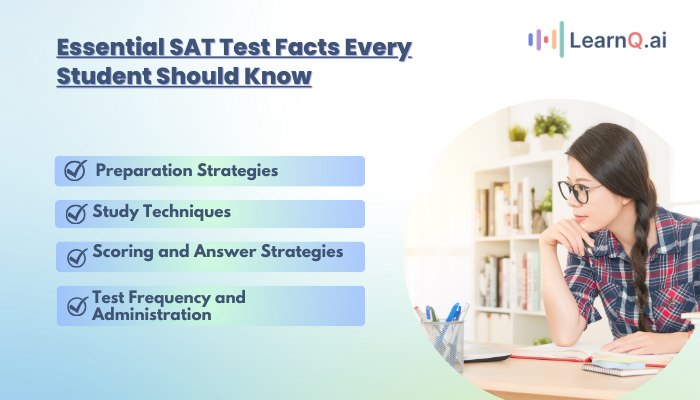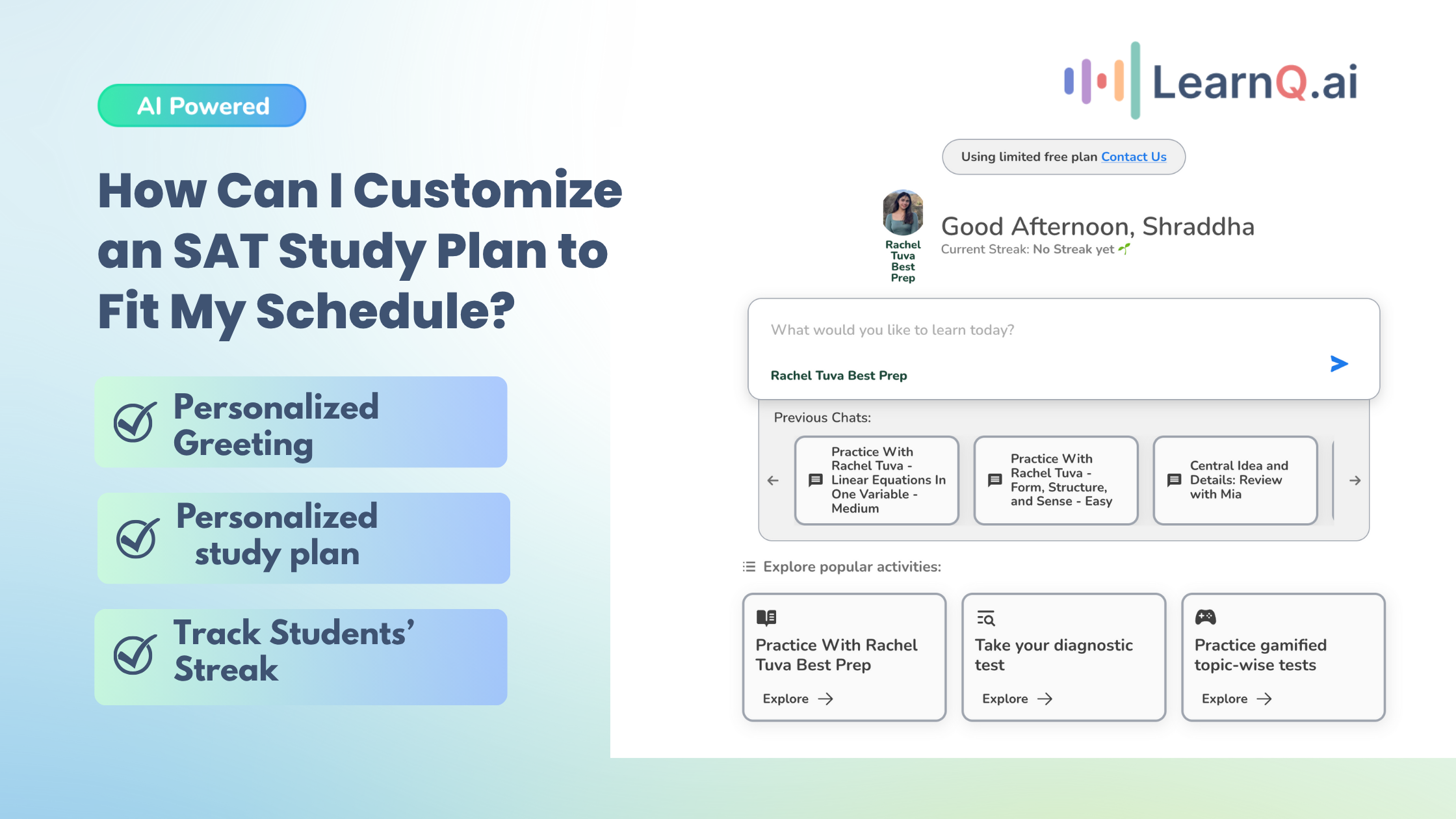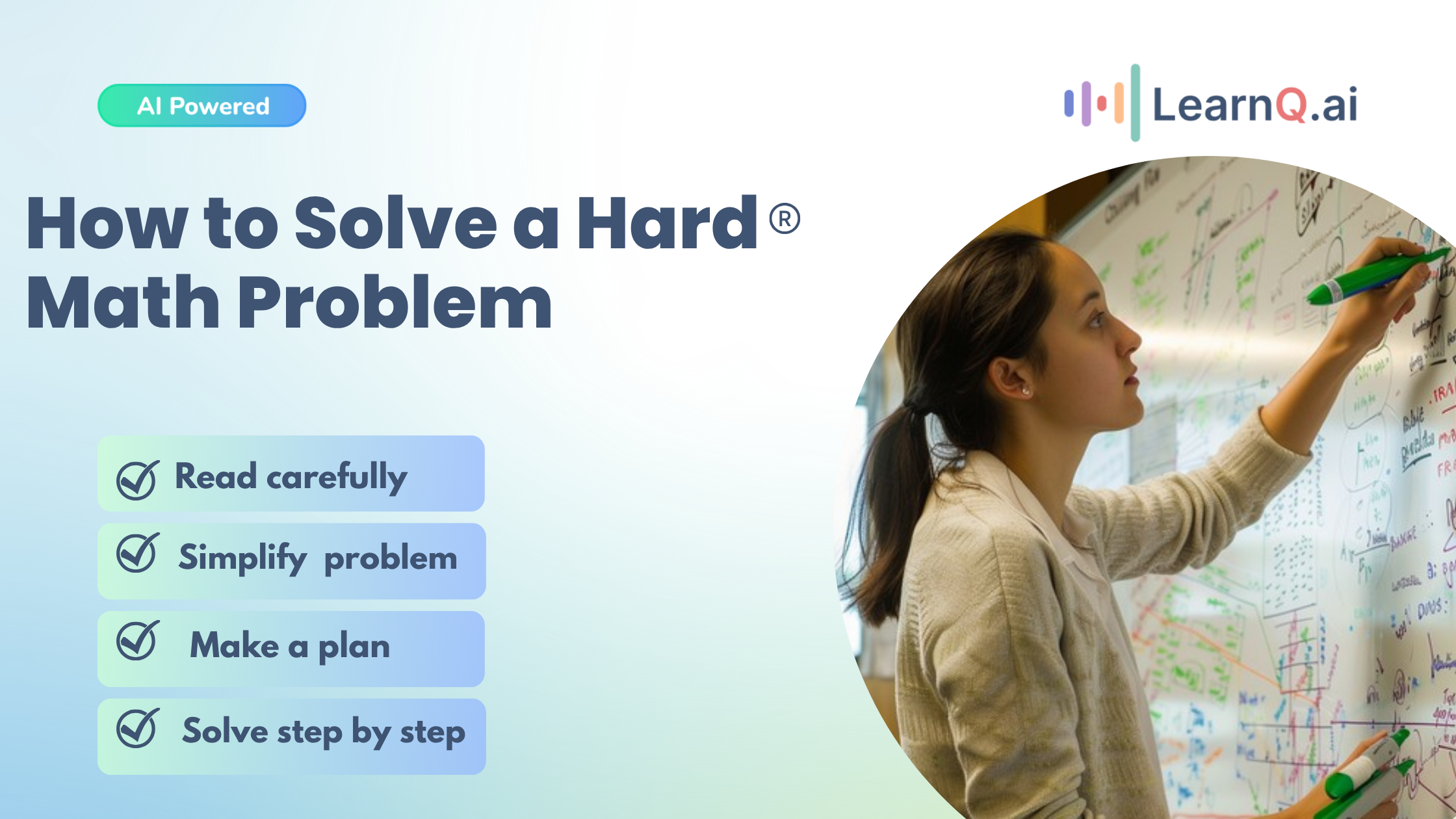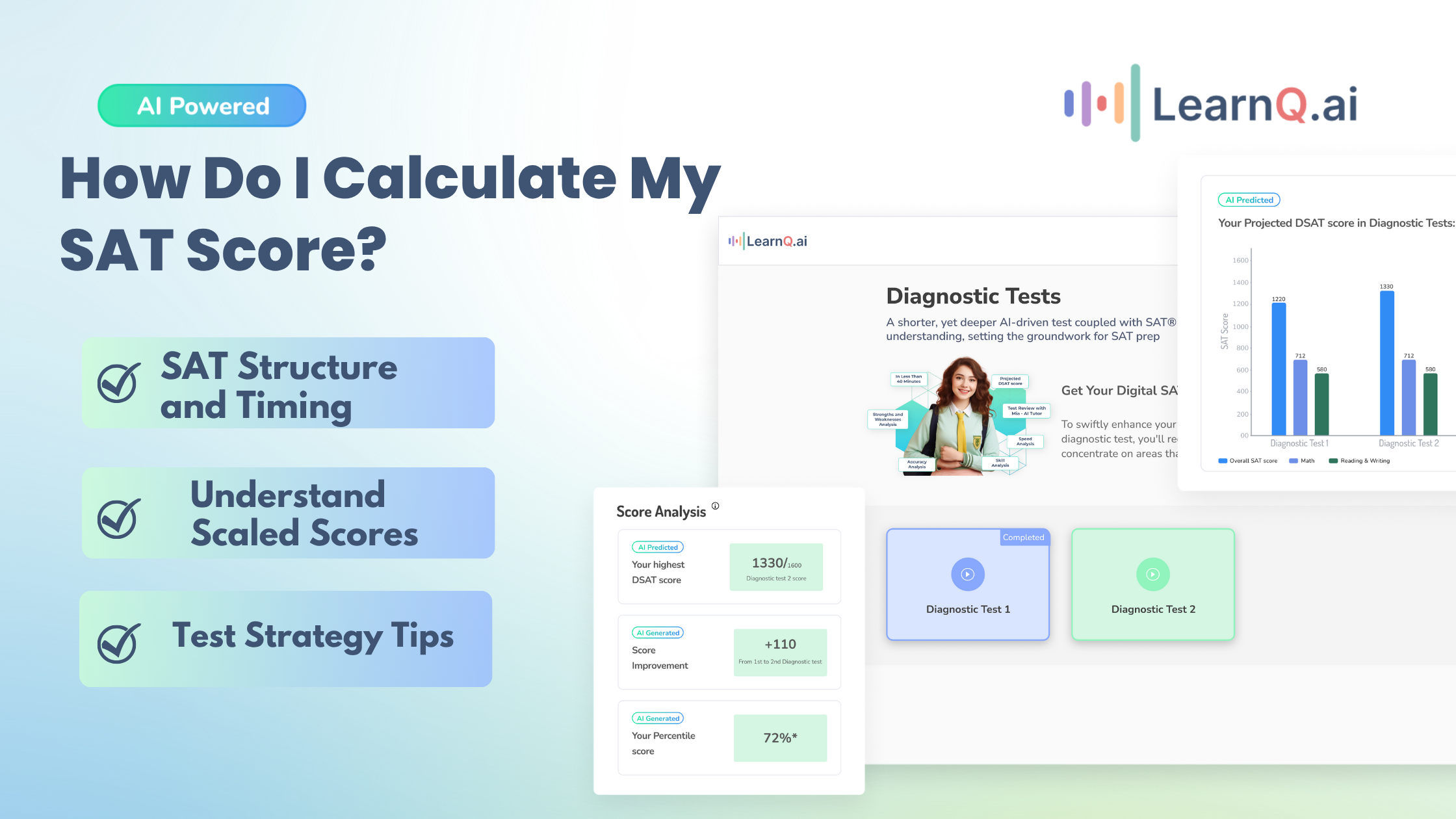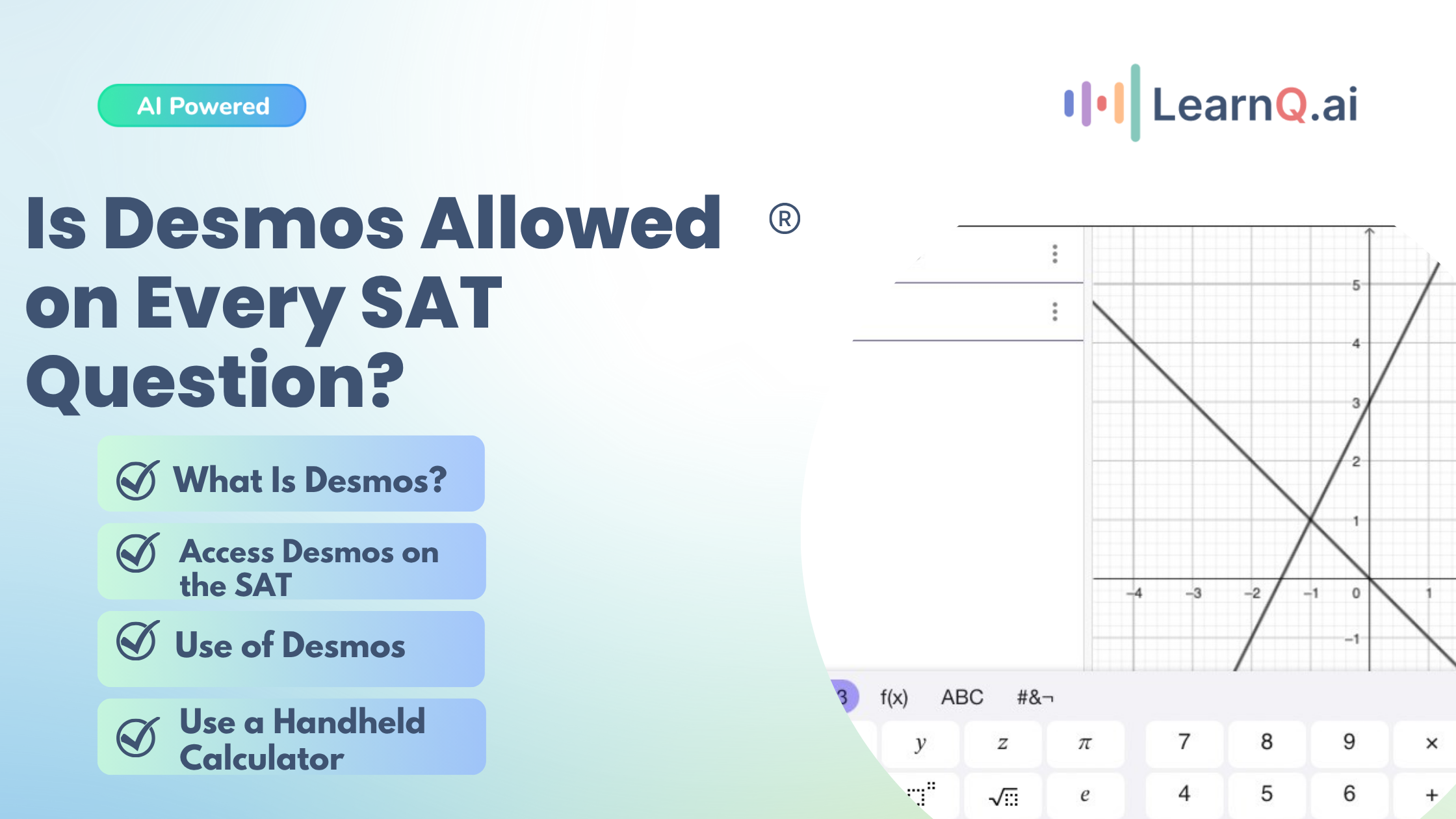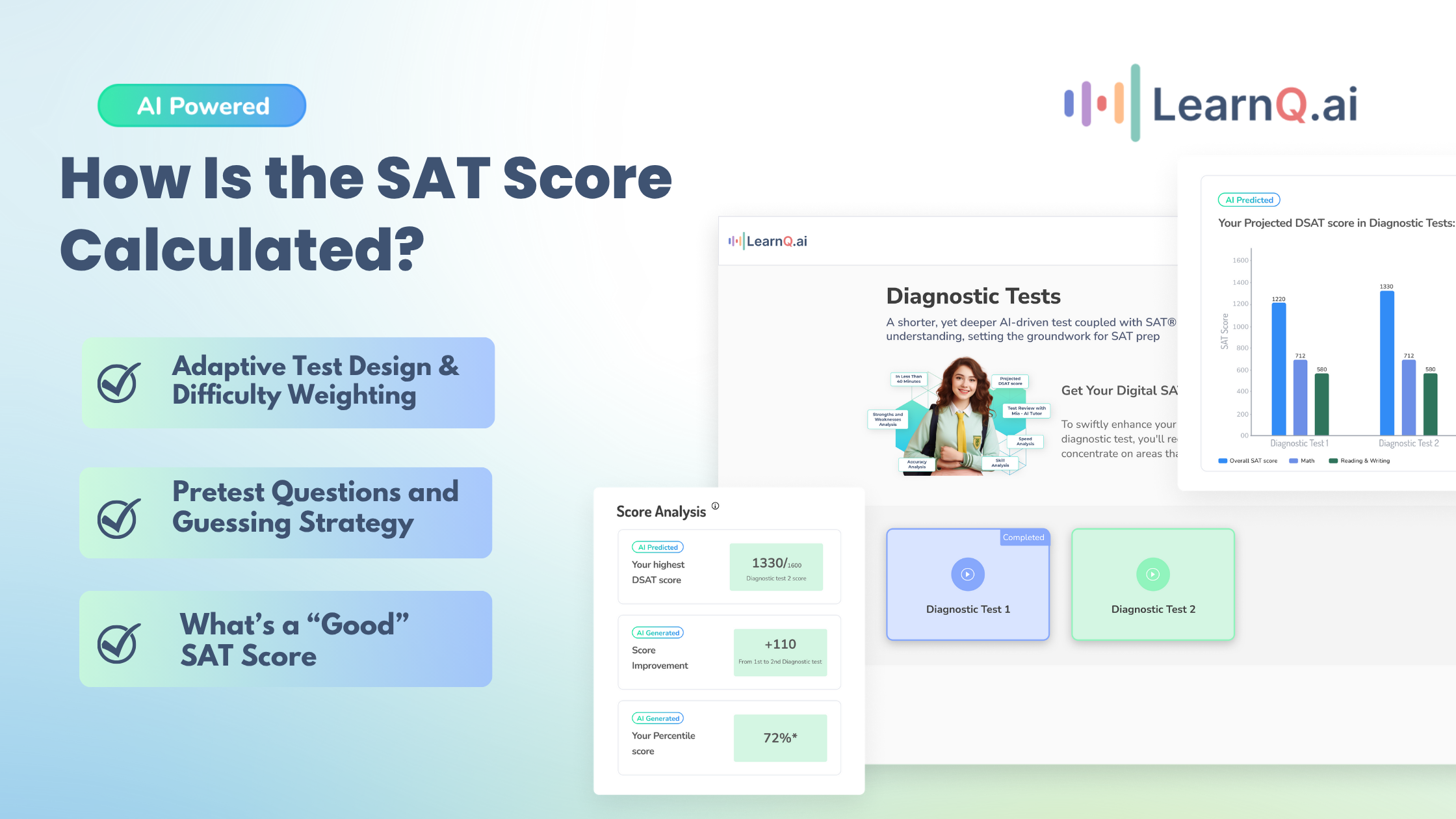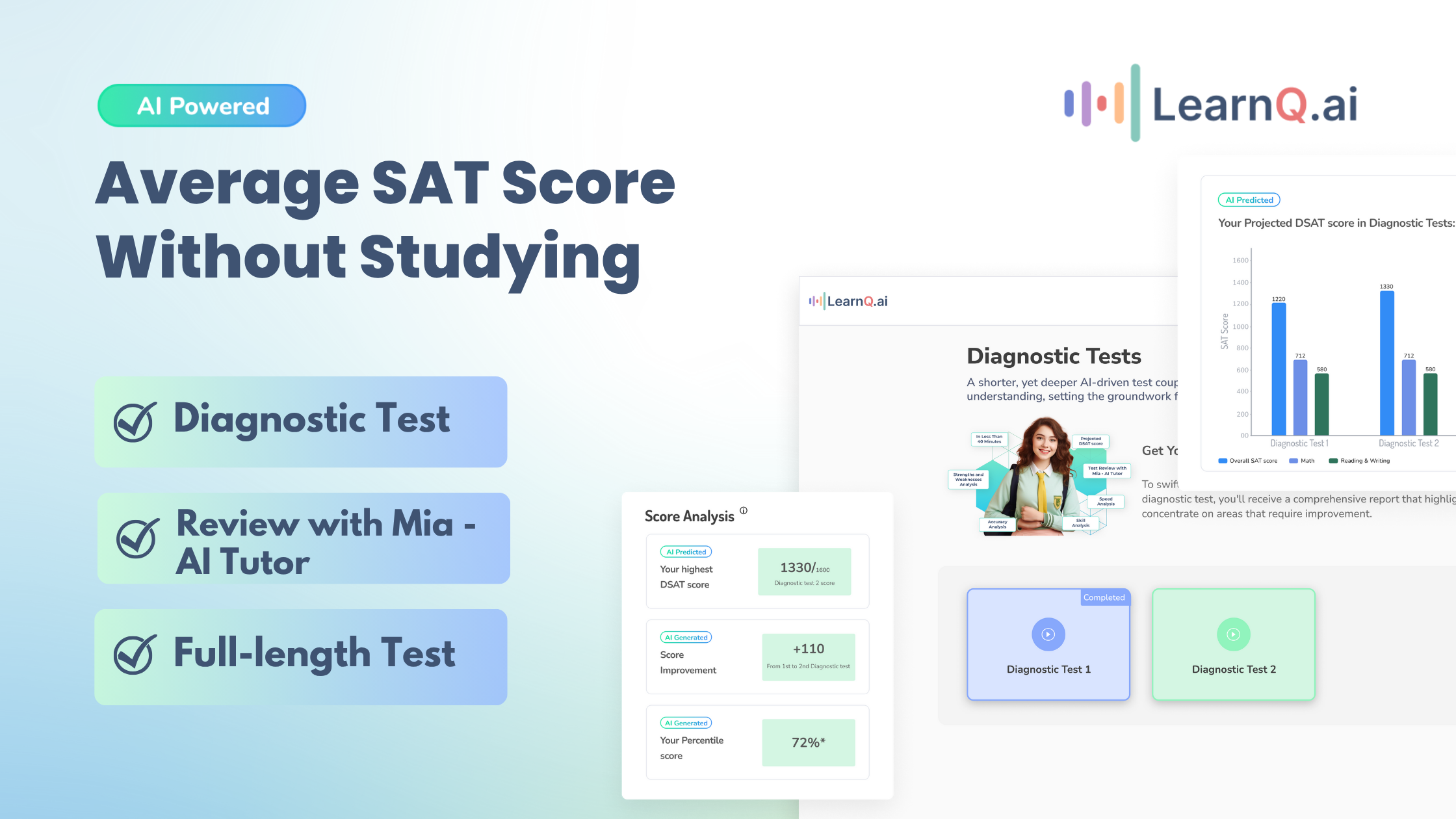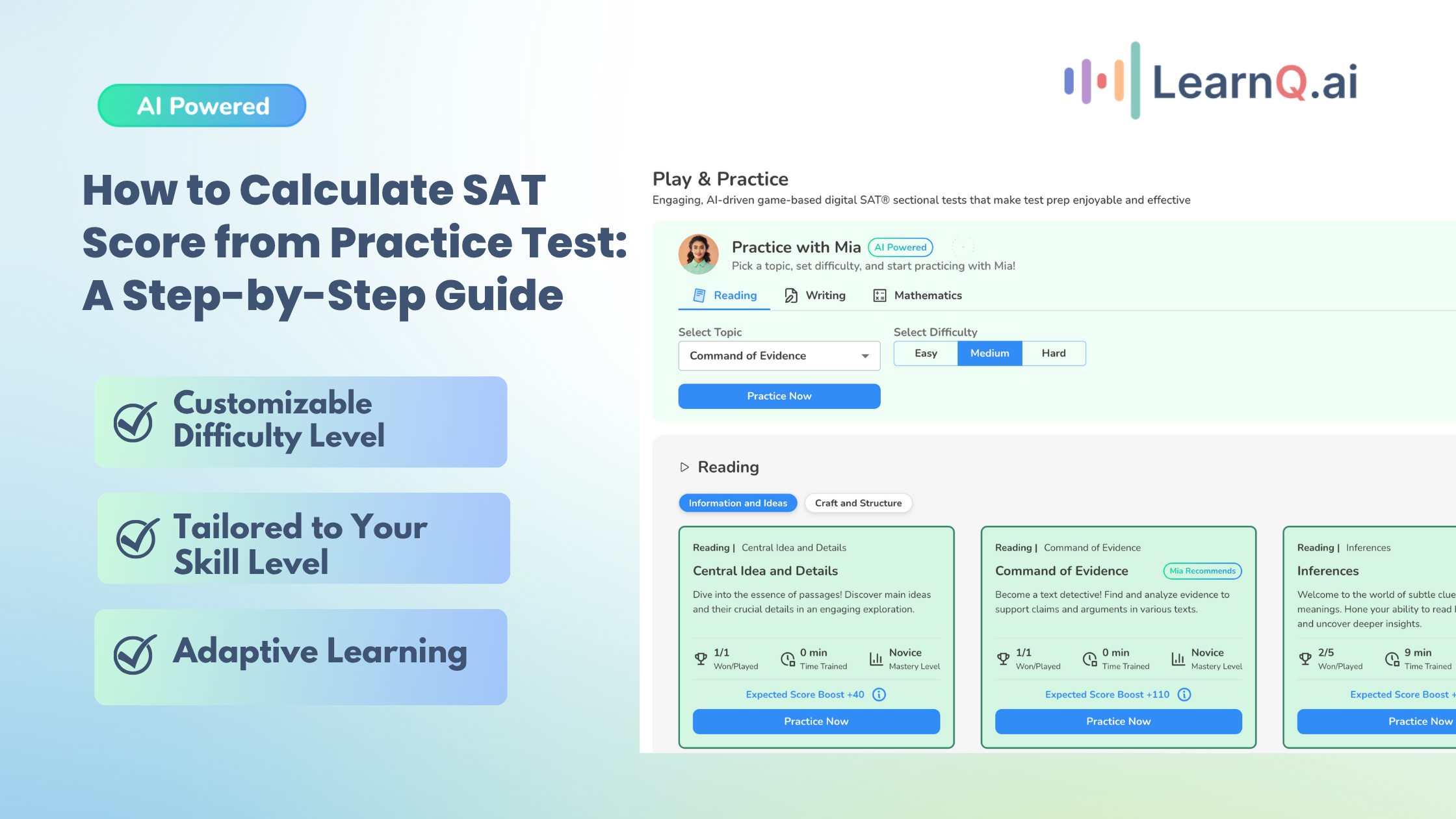Preparing for the SAT can feel like diving into a maze of numbers, scores, and benchmarks. For example, did you know that only 7% of students score between 1400–1600 on the SAT, marking them as top scorers? That’s out of over a million test-takers!
Whether you’re a student aiming for a high score, a teacher guiding your class through prep, or a parent helping your child get through the SAT journey, understanding core SAT test facts can make a big difference.
LearnQ.ai is Powered by VEGA AI—Is your Institute Next?
Give students a Duolingo-style test-prep platform with Shopify-level customization for tutors and institutes.
In this guide, you’ll get a clear look at what the SAT measures, scoring details, and how to approach the test with confidence. Let’s break down the essentials, so you know exactly what to expect.
Overview of the SAT
With the SAT evolving to meet today’s tech-driven world, the digital SAT marks a new chapter for students, parents, and educators alike. This modern format not only shifts the testing experience but also brings updates on how the test is structured and scored.
So, what exactly should you expect from the digital SAT? Here, you’ll have a walkthrough of the essentials. These include how the test is organized, what each section measures, and the scoring system that helps you understand your strengths.
Dive into what’s new and what stays the same.
- Structure of the Test
The digital SAT structure has been redesigned to streamline students’ engagement with reading, writing, and math. Splitting the test into adaptive modules allows for a more personalized assessment that matches each student’s performance level.
Key Points About the Digital SAT Structure:
- Two main sections: Reading and Writing and Math.
- Total test time: 2 hours and 14 minutes.
- Adaptive modules: Each section starts with a variety of question difficulties and adjusts in the second module based on student performance.
- A 10-minute break between the Reading and Writing section and the Math section.
- No penalty for guessing: If unsure of an answer, it’s better to guess than to leave it blank.
Here’s a closer look at the structure, timing, and key elements of each section to help you understand what to expect.
| Component | Time Allotted (minutes) | Number of Questions/Tasks | Modules |
| Reading and Writing | 64 (two 32-minute modules) | 54 | Adaptive: Adjusts after the first module based on performance |
| Math | 70 (two 35-minute modules) | 44 | Adaptive: The second module varies in difficulty |
| Total | 134 | 98 | — |
- Scoring System
The digital SAT scoring system has streamlined the way scores are calculated, making it easier to understand where you stand and how each section contributes to your total. Here’s an overview of how scoring works. A look at the top universities and their average SAT ranges will give you a benchmark for competitive scores.
Scoring System
The SAT score ranges from 400 to 1600, with each section—Reading, Writing, and Math—scored on a scale of 200 to 800. Here’s how it breaks down:
| Section | Score Range | Average Score | Description |
| Reading and Writing | 200 – 800 | 529 | Tests reading comprehension, grammar, and analytical skills scored on adaptive modules. |
| Math | 200 – 800 | 521 | It covers algebra, geometry, data analysis, and more, with a calculator allowed throughout. |
| Total Score | 400 – 1600 | 1050 | Sum of both sections: adaptive scoring adjusts based on difficulty to give a precise measure of ability. |
The digital SAT’s adaptive nature means that performance in the first module of each section influences the difficulty of the second, aiming to more accurately reflect each student’s skills.
Enhance your Digital SAT study routine with AI-driven insights and personalized practice tests.
Also Read: Know Everything About Digital SAT and PSAT/NMSQT Assessments
Top 10 Universities and SAT Score Ranges
For students aiming at top institutions, SAT scores can play a pivotal role in applications. Here’s a look at average SAT score ranges for the top 10 universities:
| University | Combined Score Range | Reading & Writing Score Range | Math Score Range |
| Massachusetts Institute of Technology | 1510 – 1580 | 730 – 780 | 780 – 800 |
| University of Chicago | 1510 – 1580 | 740 – 780 | 770 – 800 |
| California Institute of Technology | 1530 – 1580 | 740 – 780 | 790 – 800 |
| Rice University | 1490 – 1570 | 720 – 770 | 770 – 800 |
| Washington University in St. Louis | 1490 – 1570 | 730 – 770 | 760 – 800 |
| Yale University | 1480 – 1580 | 730 – 780 | 750 – 800 |
| Harvard University | 1480 – 1580 | 730 – 780 | 750 – 800 |
| Stanford University | 1470 – 1570 | 720 – 770 | 750 – 800 |
| Columbia University | 1470 – 1570 | 720 – 770 | 750 – 800 |
| Princeton University | 1460 – 1570 | 720 – 770 | 740 – 800 |
Achieving scores within these ranges can significantly boost an application’s competitiveness, although test scores are just one part of a holistic review process. Use these benchmarks to set your own goals as you prepare.
Test Frequency and Administration
When planning your SAT study plan, it’s key to understand how the test schedule works. The SAT isn’t just a one-and-done experience for most students. It’s offered multiple times a year, giving you the flexibility to choose dates that fit your preparation.
With options to take it in spring, summer, and fall, you can align your study plan with a test date that works for you. And, if needed, retake it to boost your score.
- Test Availability
For students planning their SAT study plan, 2025 offers a range of test dates to choose from, allowing flexibility in preparing for and retaking the exam if needed. The SAT is offered seven times throughout the year, giving students ample opportunities to select a date that best aligns with their preparation and college application timelines.
Here’s a quick look at the SAT dates for 2025:
| SAT Test Date | Registration Deadline | Deadline for Changes, Regular Cancellation, and Late Registration |
| March 8, 2025 | February 21, 2025 | February 25, 2025 |
| May 3, 2025 | April 18, 2025 | April 22, 2025 |
| June 7, 2025 | May 22, 2025 | May 27, 2025 |
| August 23, 2025 | August 8, 2025 | August 12, 2025 |
| October 4, 2025 | September 19, 2025 | September 23, 2025 |
| November 8, 2025 | October 24, 2025 | October 28, 2025 |
| December 6, 2025 | November 21, 2025 | November 25, 2025 |
Important Details:
- Students requiring a device from the College Board should register at least 30 days before their selected test date.
- Late registration is available worldwide for an additional fee, allowing extra time for students who might need it.
- The multiple test dates enable students to retake the SAT if they want to improve their scores or adjust their preparation strategy.
- Retaking the Test
Retaking the SAT can be a smart move if you’re aiming to improve your score or if you didn’t quite reach your target the first time around. With the option to take the SAT multiple times, students have the flexibility to try again and potentially boost their scores.
However, deciding whether to retake should be a strategic choice rather than just repeating the test. Here’s what to consider:
Why Retake the SAT?
- Score Improvement: Most students see an increase in their scores the second or third time around. Retaking gives you a chance to leverage experience and refine your skills.
- Scholarship Opportunities: Higher scores can open doors to scholarships from schools and organizations, making a higher SAT score financially rewarding.
- Superscoring Advantage: Many colleges superscore, meaning they’ll consider the highest section scores across multiple test dates, potentially boosting your application profile.
- Increased Confidence: With firsthand experience, you know the test format, timing, and question types, which can make you more confident and prepared for a second attempt.
When to Consider Retaking?
- Timing: Most students take the SAT in the spring of junior year and again in the fall of senior year, allowing time for improvement without delaying college applications.
- Target Score: If your score is just shy of your target range, especially for your chosen colleges, it might be worthwhile to retake the test.
- College Admissions Deadlines: Ensure that your retake schedule aligns with application deadlines, particularly if you’re aiming for early decision or early action admissions.
Tips for Preparing for a Retake
- Review Past Scores: Look into areas where you scored lower and focus your study efforts there.
- Practice Regularly: Use resources like the College Board’s Official Digital SAT Prep on Khan Academy and full-length practice tests through Bluebook™.
- Set a New Target: Determine a realistic score goal based on the college requirements and your previous performance.
- Self-Care: While preparing is essential, so is taking care of your well-being. Avoid unnecessary stress by setting clear goals and realistic expectations.
Preparation Strategies with LearnQ
Preparation for the SAT is about more than just practice tests and study hours,, and it’sabout using the right resources to unlock potential and maximize strengths. With LearnQ, students and educators gain access to personalized tools designed to guide learners toward their highest possible scores.
However, what truly sets LearnQ apart is the success stories of students who transformed their SAT performance using its tailored features.
From real-time analytics to adaptive quizzes, LearnQ offers tools that build knowledge and enhance confidence.
Get into the standout features that have helped students across the country reach their SAT goals and beyond.
- Free Diagnostic Test: Assess your current skills and create a customized study plan. LearnQ’s diagnostic tests predict your SAT score and guide you in developing an effective study strategy.
- Practice and Play: Engage with LearnQ’s SAT Practice Tests and DSAT Practice Tests for 2024. Experience a gamified, adaptive learning environment with over 10,000 new Digital SAT questions based on the College Board’s latest pattern.
- Full-Length Tests: Challenge yourself with Full-length DSAT Practise Tests. LearnQ provides digital SAT questions and resources, including access to Bluebook DSAT Test 2024, for a realistic testing experience.
- AI Tutor: LearnQ’s AI Tutor, Mia, offers personalized learning support. Whether you need help with Math or prefer tailored guidance, Mia adapts to your learning pace and style to ensure a focused study approach.
Study Techniques
LearnQ’s sectional tests are designed to help students focus on their strengths and identify areas for improvement in specific sections of the SAT, such as Math, Reading, and Writing.
By breaking down the test into these core sections, students can target their study efforts where it matters most, making their preparation both efficient and effective.
- Targeted Practice: Sectional tests allow you to zero in on one area at a time. Whether it’s brushing up on algebra in Math or honing grammar skills in Writing, focusing on each section individually helps solidify core concepts.
- Efficient Time Management: LearnQ’s sectional tests help you determine which areas need more attention so you can allocate study time to where it’s most impactful. Instead of spreading yourself thin, you can dedicate more time to sections that need improvement.
- Performance Insights: After each test, LearnQ provides detailed feedback on performance, highlighting both strengths and areas that need work. These insights allow students to tweak their study plans and prioritize areas that will boost their overall scores.
- Skill Building in Smaller Bites: Tackling the SAT can feel overwhelming, but sectional tests allow you to work on the test in manageable segments. This builds confidence and mastery gradually.
- Progress Tracking: LearnQ’s tools allow you to track improvements over time in each section, motivating you to keep striving toward your goal score.
Enhance your Digital SAT study routine with AI-driven insights and personalized practice tests.
Scoring and Answer Strategies
When it comes to mastering the SAT, knowing a few key SAT test facts about scoring and answer strategies can make all the difference. Knowing how each answer affects your score and mastering strategies for tough questions is key to effective SAT prep.
A solid grasp of these details can help you maximize your score potential and reduce anxiety on test day.
Read on to understand how the SAT scoring system works and learn some innovative strategies for answering questions efficiently and accurately.
- Understanding the Scoring
The digital SAT introduces an adaptive scoring system that gives a more precise picture of each student’s skills in less time. By adapting question difficulty based on performance, this system offers a tailored assessment that reflects each student’s unique strengths and areas for improvement. Here’s how it works:
- Adaptive Test Design: Each SAT section—Reading and Writing, and Math—is divided into two modules. The first module includes a mix of question difficulties, while the second module adjusts its difficulty level based on the student’s performance in the first module. This adaptive approach allows the test to assess students’ abilities with fewer questions.
- Score Range and Benchmarks: The digital SAT still uses the 400–1600 scoring scale, with each section (Reading and Writing, Math) scored from 200 to 800. College and Career Readiness Benchmarks remain unchanged at 480 for Reading and Writing and 530 for Math, allowing students to gauge their readiness for post-secondary paths.
- Item Response Theory (IRT): The SAT scoring incorporates IRT, which considers factors like question difficulty and response patterns. This model is used widely in national assessments to ensure fair scoring, as it accounts for the complexity of questions answered correctly.
- Pretest Questions: Each module includes two pretest questions, which don’t affect the score but help the College Board assess questions for future use.
- No Penalty for Guessing: Since incorrect answers don’t lower your score, it’s advantageous to answer every question, especially if you can narrow down the choices.
This adaptive scoring model means that even if students receive a different mix of questions, they still have an equitable opportunity to achieve scores that accurately reflect their abilities.
Also Read: What is the Highest Score on ACT and SAT Tests?
- Answer Strategies
Mastering answer strategies on the SAT can boost both speed and accuracy, helping you make the most of each question. Here are key tactics to keep in mind:
- Strategic Answering with LearnQ’s Analytics
LearnQ’s personalized analytics are designed to help students optimize both pacing and accuracy. By tracking individual performance on practice tests, LearnQ identifies where time is spent efficiently and where improvements can be made.
This precision allows you to maximize your scoring potential, focusing on answering accurately within the given time. LearnQ’s insights offer a clear roadmap for better test management, tailoring study strategies to boost performance in each section.
- Time Management Techniques
Effective time management is essential for success on the SAT, as it ensures you can thoughtfully tackle each question without feeling rushed. Here are some strategies to help you stay on track and make the most of every minute:
- Prioritize Easy Wins: Start by answering the questions you find easiest. This helps you secure quick points and build confidence, saving tougher questions for later when you have time to focus.
- Set Time Goals per Section: Divide the total time for each section by the number of questions to determine a rough time goal per question. Stick to this pacing to prevent spending too long on any single question.
- Use Process of Elimination: Narrowing down choices before answering saves time and increases your odds of selecting the correct answer, especially if you’re unsure of the exact answer.
- Mark and Move: If you encounter a particularly difficult question, mark it and move on. Plan to return to these marked questions with any remaining time at the end.
- Practice with Timed Tests: Regularly practicing with timed sections helps you develop a natural pacing rhythm so you feel comfortable working within the actual time constraints on test day.
- Guessing Strategies
When faced with challenging questions, strategic guessing can be a smart choice. LearnQ’s real-time feedback helps students refine their decision-making skills, guiding when it’s best to make an educated guess. With no penalty for wrong answers, using this approach can maximize your chances of scoring points without losing time.
- Math Section Focus
Sharpening your approach to the SAT Math section involves smart use of tools and a focus on key concepts. Here’s what to prioritize:
- Calculator Usage: Certain SAT math questions permit calculator use, and knowing how to use one effectively can be a game-changer. LearnQ’s practice sessions integrate calculator-friendly questions, allowing you to practice this skill and develop efficient strategies.
- Content Focus: The SAT Math section emphasizes algebra, with a built-in formula reference to support test-takers. LearnQ’s adaptive learning features provide targeted practice in algebraic concepts, ensuring that you’re well-prepared to tackle these questions confidently.
- Optional Essay
To excel in the SAT’s optional essay, strong skills in passage analysis and argument construction are essential. You’ll need to break down the author’s argument and build a well-supported response, clearly articulating your analysis and using evidence effectively.
Also, use LearnQ’s AI tutor, Mia, who offers instant feedback on practice essays, helping you refine your argumentation and evidence presentation. This feedback loop allows you to strengthen your writing skills and enhance your essay’s clarity and structure.
Also Read: Report SAT Essay On Common App & Combining Them.
LearnQ.ai is powered by VEGA AI—Is your institute next?
Offer students a Duolingo-style test-prep platform with Shopify-level customization for tutors and institutes.






Conclusion
A strategic approach to SAT preparation can make a tremendous difference in your results, giving you the focus and confidence needed to reach your target score. From understanding core SAT test facts to applying effective answer strategies, every step in your prep journey counts.
To maximize your SAT success, explore LearnQ’s all-in-one SAT prep tools, which include diagnostic tests, full-length practice exams, and personalized feedback to guide your progress.
Ready to take the next step? Join our SAT student community on Discord, where you can connect with peers and share study tips. Also, check out LearnQ’s step-by-step guide to get started. With LearnQ, you’ll be well-prepared to achieve your best on test day!

